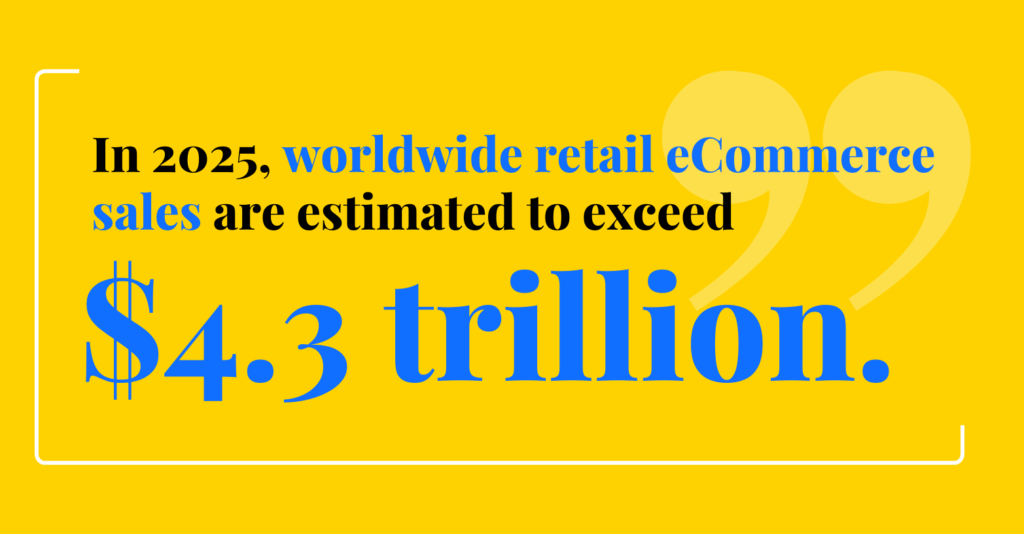The digital marketplace continues its explosive growth trajectory. Retail eCommerce sales are estimated to exceed 4.3 trillion U.S. dollars worldwide in 2025. Today, around one-third of humanity—2.77 billion people—shops online, with digital purchases accounting for a record 21% of all retail transactions.
For mid-sized companies, a smart, strategic approach to e-commerce is required to survive and succeed. This guide strips away the complexity to deliver battle-tested strategies that drive measurable results.

In this guide:
For over a decade, Session Interactive has helped eCommerce brands drive measurable growth through targeted and impactful digital marketing strategies. By blending hands-on experience, deep industry expertise, and a genuine passion for understanding each client’s unique needs, we deliver real, revenue-driving results.
Creating an eCommerce Marketing Plan
Before tackling tactics, you need a roadmap: A well-structured marketing plan aligns your efforts with business goals, optimizes resource allocation, and establishes clear success metrics.
Identify Your Target Audience
Who are your ideal customers? Develop detailed buyer personas covering demographics, online behaviors, pain points, and purchase motivations. This knowledge shapes everything from messaging to channel selection.
With over 90% of consumers now regularly shopping via smartphone, your data might reveal a predominantly mobile audience, demanding a mobile-first approach across all touchpoints.
Define Your Objectives & KPIs
Set concrete, measurable goals, whether you aim to boost sales volume, strengthen customer retention, or increase average order value.
Track metrics that matter: conversion rate, customer acquisition cost (CAC), lifetime value (CLV), cart abandonment rate, and return on ad spend (ROAS). Choose benchmarks aligned with your specific business objectives.
Develop Your Brand Positioning and Messaging
Your unique value proposition must shine consistently across all channels. Articulate what sets your products apart and why customers should choose you over competitors.
Effective positioning transcends product features to forge emotional connections. Address customer pain points directly and communicate tangible benefits they’ll experience when choosing your brand.
Analyze Your Competitors
A thorough competitive analysis often reveals market gaps and differentiation opportunities.
Examine competitors’ product offerings, pricing strategies, marketing tactics, and customer experience to benchmark your performance. Study their online presence closely—website design, user experience, content strategy, and social engagement. Use tools like SEMrush or Ahrefs to unveil their SEO strategies and paid advertising approaches, helping refine your tactics.
Set a Budget
Determine realistic marketing investments. Consider industry benchmarks for customer acquisition costs and allocate budget across channels based on your objectives and audience behaviors.
New ventures might start with focused spending on a few key channels, scaling based on performance data. Established businesses can leverage historical metrics to optimize channel allocation. For context, eCommerce leaders collectively invested $3.5 billion in advertising last year, with individual companies spending between $41.3 million and $1.7 billion.
Choosing eCommerce Marketing Channels
Choosing the right channel mix helps you reach your target audience while maximizing ROI. Each channel offers distinct advantages and should be evaluated against your specific goals, audience, and resources.
SEO
Search engine optimization delivers unmatched long-term ROI for eCommerce businesses. Optimizing product pages, category listings, and content for relevant keywords drives qualified traffic without ongoing ad spend.
Beyond keywords, you should focus on technical elements: site speed, mobile responsiveness, and structured data that helps search engines understand and showcase your products. Craft detailed product descriptions and develop content addressing informational queries related to your offerings.
Unlike high-churn paid channels, SEO builds a sustainable traffic foundation that compounds over time—particularly valuable as third-party cookies disappear and privacy regulations tighten. By continuously scaling content, eCommerce brands can expand visibility, attract new audiences, and strengthen long-term growth.
Social Commerce
Shopping functionality embedded within social platforms transforms passive scrollers into active buyers. With 5 billion global social media users [SellersCommerce, 2025], these integrated purchasing pathways eliminate friction between discovery and conversion.
Instagram, Facebook, and Pinterest offer shoppable posts, while TikTok and YouTube have built robust commerce features. Livestream shopping represents the next frontier—China’s live commerce market will reach $843 billion in 2025, while U.S. livestreaming will triple to $31 billion compared to 2021 levels [Shopify, 2025].
The power of social commerce lies in contextual relevance: showcasing products within the environments where consumers already spend hours daily.
Online Marketplaces
Amazon, eBay, Walmart, and Etsy offer instant access to massive, purchase-ready audiences. These platforms complement your direct website strategy with expanded reach and visibility.
Optimize marketplace listings with high-resolution imagery, comprehensive descriptions, and competitive pricing. Consider fulfillment services like Amazon FBA to enhance delivery speed and customer satisfaction. Balance the benefits against marketplace fees and intense competition.
PPC
Pay-per-click advertising places your products precisely where customers actively search for solutions. Google Shopping ads dominate this space, generating 76.4% of retail search ad spend.
PPC delivers immediate visibility with laser-focused targeting based on keywords, demographics, interests, and behaviors. These campaigns generate valuable data for continuous optimization while offering flexibility to scale spending based on seasonality and performance. For maximum impact, create dedicated landing pages for your ads and relentlessly test creative elements, messaging, and targeting parameters.
Display Advertising
Visual storytelling through images, videos, and interactive elements captures attention across the digital ecosystem. Display ads excel at building brand awareness and reconnecting with visitors who haven’t converted.
AI-powered programmatic platforms optimize placement and targeting in real-time, enhancing efficiency. Connected TV (CTV) represents a high-growth opportunity, with U.S. advertising spend projected to surge from $25 billion in 2023 to $41 billion by 2027.
Social Media Advertising
Social platforms offer unmatched targeting precision based on demographics, interests, behaviors, and life events. These environments enable visually compelling ads that blend seamlessly with organic content.
Each platform serves distinct purposes: Facebook and Instagram provide broad reach with diverse formats; LinkedIn excels for B2B products; Pinterest drives purchase intent; TikTok captivates younger audiences through immersive short-form video.
Experiment across platforms to identify which environments deliver the strongest performance for your specific products and customer segments.
Retargeting & Remarketing
Reconnecting with users who’ve already shown interest typically delivers higher conversion rates than cold prospecting. These campaigns reach people familiar with your brand but who haven’t completed purchases.
Implement pixel tracking to build custom audience segments across platforms. Tailor messaging based on specific behaviors—product page views, cart abandonment, or previous purchases. Personalized retargeting drives exceptional results, with properly segmented campaigns achieving ROIs exceeding 1,300%.
Influencer Marketing
Strategic influencer partnerships extend your reach while borrowing established credibility. Micro-influencers in niche markets often deliver higher engagement with hyper-relevant audiences.
When evaluating potential collaborators, prioritize engagement over follower count. Calculate potential reach using this formula: (Average views on their last 5 posts/5) × 100 = Approximate campaign reach. Provide clear guidelines while preserving the authentic voice that attracted their audience initially.
Email Marketing
Email remains the performance workhorse, generating an average 36:1 return on investment. Unlike algorithm-driven platforms, you own your email list and maintain direct access to subscribers.
Segment subscribers by purchase history, browsing behavior, and engagement patterns to deliver personalized content that resonates with each group. Implement automated sequences for welcome series, abandoned carts, post-purchase nurturing, and win-back campaigns.
Abandoned cart emails generate the highest revenue per recipient ($3.65) and highest conversion rate (3.33%) among all email flows—making them the highest-priority automation to implement.
Content Marketing
Strategic content establishes your brand as an industry authority while driving organic traffic and supporting customer education throughout their journey. Create resources that answer real questions, solve problems, and showcase products in context.
Develop diverse content types: buying guides, tutorials, comparison articles, success stories, and educational blog posts. Optimize for search visibility and repurpose across channels to maximize impact and efficiency.
Content marketing supports the complete customer lifecycle, from initial awareness through post-purchase support and loyalty development.
Video Marketing
Video content has transformed from luxury to necessity for eCommerce brands. It showcases products in action, creates emotional connections, and significantly boosts conversion by providing deeper product understanding
Create product demonstrations, unboxing experiences, customer testimonials, behind-the-scenes glimpses, and how-to tutorials. Adapt formats for platform requirements—short-form for TikTok and Instagram, longer content for YouTube—and include clear calls-to-action.
As Connected TV advertising accelerates, video content increasingly serves as the central pillar of sophisticated eCommerce marketing strategies.
Affiliate Marketing
Strategic partnerships with publishers, content creators, and relevant websites extend your reach through performance-based promotion. This model delivers cost efficiency since you pay only for actual conversions.
Structure competitive commission rates and equip affiliates with essential resources: high-quality images, compelling product descriptions, and reliable tracking links. Monitor performance regularly and nurture relationships with top producers to maximize results.
Event Marketing
Virtual and physical events forge meaningful customer connections while driving brand engagement. Consider webinars, virtual product launches, livestream shopping events, pop-up experiences, or industry trade shows.
Events showcase products in dynamic settings, provide real-time interaction, and gather invaluable customer feedback. They generate content for other marketing channels while building your prospect database.
18 Actionable eCommerce Marketing Strategies & Tactics
With foundations and channels established, let’s explore specific, proven strategies to drive measurable results. These approaches work across diverse eCommerce sectors and can be tailored to your unique business needs.
1. Optimize Your Website for Speed and User Experience (UX)
Loading delays and navigation frustrations directly impact your bottom line. Optimizing site layout ranks among the most effective strategies for enhancing engagement and driving conversions.
Slash page load times by compressing images, minimizing script bloat, and implementing browser caching. Create intuitive navigation paths that guide visitors effortlessly toward purchase. Regularly conduct user testing to identify and eliminate friction points that impede conversion.
2. Personalize Customer Experience
Generic shopping experiences no longer suffice. Nearly one-third of millennials (28%) demonstrate increased loyalty when receiving personalized communications.
Deploy AI-powered recommendation engines that analyze behavioral data to suggest relevant products. Implement dynamic content that adapts based on visitor history—displaying recently viewed items or tailored category pages. Personalize email messaging with product suggestions aligned with individual preferences.
The impact is clear: personalized product recommendations on exit popups have boosted revenue by up to 26.3%.
3. Improve Product Pages for Conversion
Product pages represent your critical conversion battleground. While the average eCommerce conversion rate hovers at 1.81%, optimized pages can dramatically outperform this benchmark.
Craft compelling descriptions that address customer questions and emphasize benefits over technical specifications. Showcase products through high-resolution imagery and videos from multiple angles and in practical contexts. Incorporate authentic customer reviews to build trust—social proof significantly influences purchase decisions.
Design clear, action-oriented CTAs and systematically test different offers (discounts vs. free shipping) to identify what drives the strongest response from your specific audience.
4. Offer Free Shipping and Flexible Returns
Shipping costs and complicated return policies trigger cart abandonment while transparent shipping and return policies help establish that critical trust.
Provide free shipping above specified order thresholds to encourage larger purchases while reducing abandonment. Clearly communicate your return policy throughout the shopping journey. Consider offering free returns or in-store return options for online purchases to minimize purchase hesitation.
Make these policies instantly findable and understandable with straightforward language that builds confidence at each decision point.
5. Implement a Loyalty or Rewards Program
Retaining existing customers typically costs less than acquiring new ones. For many eCommerce businesses, strategic upselling and cross-selling to current customers delivers better returns than pursuit of new prospects.
Design a points-based loyalty program where purchases earn redeemable rewards. Offer exclusive benefits for repeat customers—early access to new products, VIP discounts, or priority customer service. Consider tiered structures that unlock progressively valuable benefits as customers reach higher spending thresholds.
Promote your loyalty program prominently throughout your site and in post-purchase communications to maximize enrollment and ongoing engagement.
6. Run Time-Limited Sales and Promotions
Strategic urgency drives immediate action. Data shows cart abandonment reaches its annual low in December (77% versus January’s 82% peak), directly attributable to holiday promotions and discount availability.
Launch flash sales with strict time limits to accelerate decision-making. Deploy countdown timers on product pages and checkout screens to visually reinforce limited availability. Create exclusive, time-bound offers for email subscribers and social followers to boost engagement across channels.
Plan your promotional calendar strategically around seasonal trends and inventory management to balance sales volume with profitability.
7. Implement Abandoned Cart Recovery
With 70.19% of online shopping carts abandoned, recovery strategies recapture substantial lost revenue. Cart abandonment represents $260 billion in recoverable sales across the U.S. and EU alone.
Deploy automated email sequences to reconnect abandoners with their forgotten items. One-third of post-abandonment email clicks result in completed purchases. Segment recovery messages based on cart value, customer history, and product category for maximum relevance.
Consider offering graduated incentives in follow-up communications to overcome price objections. Supplement email recovery with strategic retargeting ads that remind shoppers of abandoned items as they browse elsewhere.
8. Utilize Retargeting Campaigns
Reconnect with visitors who’ve shown interest but haven’t converted. Social media traffic produces the highest abandonment rate (77.54%), while search (63.81%) and direct traffic (69.39%) demonstrate stronger purchase intent.
Show visitors the exact products they viewed previously through dynamic retargeting. Create segmented campaigns based on specific behaviors—product views, category browsing, or add-to-cart actions. Develop sequenced messaging that addresses different potential objections at each touchpoint.
Consider strategic cross-selling of complementary products within retargeting campaigns to boost average order value while solving additional customer needs.
9. Streamline the Checkout Process
Checkout complexity directly correlates with abandonment rates. Optimizing the checkout experience alone can increase conversion rates by up to 35.26%.
Minimize required form fields, collecting only essential information. Offer diverse payment options, including digital wallets and buy-now-pay-later solutions. Enable guest checkout to eliminate registration barriers. Display security badges and reassurances throughout the payment process to address data protection concerns.
10. Leverage User-Generated Content (UGC)
Customer-created content builds authentic trust that brand-produced materials cannot match. UGC significantly influences purchase decisions through genuine social validation.
Encourage customers to share product experiences through post-purchase communications and social campaigns. Feature these authentic materials on product pages and social channels. Create submission-based contests that generate engagement while building your UGC library.
Establish branded hashtags that simplify content collection and create community around your products. The authenticity of customer-created content cuts through marketing skepticism in ways traditional approaches cannot achieve.
11. Focus on Customer Service and Support
Superior support builds trust, enhances satisfaction, and encourages repeat business. It also reduces returns and negative reviews by addressing concerns proactively.
Implement live chat to answer pre-purchase questions in real-time, eliminating information gaps that cause abandonment. Develop comprehensive self-service resources that empower customers to resolve common issues independently.
Deploy AI chatbots for 24/7 basic assistance with clear escalation paths to human agents for complex issues. Train support teams to identify personalized recommendation opportunities, transforming service interactions into revenue-generating touchpoints.
12. Launch a Referral Program
Word-of-mouth recommendations carry unmatched credibility. Referral programs systematize this powerful influence by incentivizing customers to advocate for your brand.
Reward existing customers for bringing new buyers to your business. Create easily shareable referral mechanisms—personalized links or promo codes—with reliable tracking. Position your referral program prominently throughout the customer journey, including post-purchase communications and account dashboards.
Consider dual-sided incentives that reward both referrer and new customer to maximize participation and conversion.
13. Use Upselling and Cross-Selling Techniques
Strategic product recommendations significantly increase average order value and customer lifetime value.
Suggest complementary items during checkout and on product pages based on purchase patterns. Create discounted product bundles that encourage multi-item purchases. Recommend premium alternatives when customers view entry-level products, highlighting additional features and benefits.
Personalize recommendations based on browsing patterns and purchase history to maximize relevance and conversion probability.
14. Optimize for Voice Search
Voice-activated shopping continues its rapid expansion. Successful eCommerce strategies now require optimization for natural language queries and conversational keywords.
Adapt product titles and descriptions for spoken search patterns. Focus on conversational long-tail keywords that mirror how people talk rather than type. Strengthen your local SEO foundation, as many voice searches include location intent.
Develop FAQ content directly answering common product and category questions, as voice search results frequently pull from question-and-answer formats. This approach positions your products for discovery as voice commerce becomes increasingly mainstream.
15. Implement Social Proof
Strategic social validation reduces perceived risk and builds purchase confidence. The industry average add-to-cart rate of 2.34% increases substantially with effective social proof implementation.
Display real-time purchase notifications to create urgency and validation (“10 people purchased this item in the last hour”). Feature authentic customer reviews on product pages, including both enthusiastic feedback and your responses to concerns.
Showcase cumulative metrics—products sold, customers served, satisfaction ratings—to demonstrate reliability at scale. Highlight media mentions, awards, and certifications that substantiate your brand’s credibility and quality standards.
16. Create Exclusive Membership or Subscription Programs
Subscription models generate predictable revenue while enhancing customer loyalty through ongoing value and convenience.
Launch subscription offerings for consumable products, eliminating repurchase friction. Develop VIP membership tiers with exclusive benefits—priority access to new releases, members-only discounts, and complimentary shipping.
Personalize subscription recommendations based on individual preferences and enable flexible customization to boost satisfaction and retention. Implement seamless subscription management allowing customers to easily modify, pause, or resume their plans without friction.
17. Optimize Product Listings for SEO
SEO-optimized product listings drive qualified organic traffic without ongoing ad spend. Organic channels consistently deliver superior ROI compared to paid alternatives.
Integrate relevant keywords throughout product titles, descriptions, and metadata to improve search visibility. Implement structured data markup to enhance search result displays with rich features like pricing, availability, and ratings.
Create unique, detailed descriptions rather than using manufacturer-provided content to avoid duplicate content penalties. Optimize product images with descriptive filenames and alt text containing strategic keywords.
18. Segment Customers for Targeted Campaigns
Precise customer segmentation enables hyper-relevant marketing that drives engagement and conversion. Targeted approaches consistently outperform generic messaging.
Segment email subscribers based on purchase history, geographic location, and behavioral patterns. Develop personalized ad campaigns reflecting specific customer preferences and interactions. Create distinct messaging for first-time buyers versus established customers, acknowledging their unique relationship stages.
Apply RFM analysis (Recency, Frequency, Monetary value) to identify your most valuable customer segments and develop specialized retention strategies for these high-value relationships.
Partner with Session Interactive for eCommerce Marketing Success
In e-commerce, having an experienced partner can mean the difference between stagnation and explosive growth. At Session Interactive, we combine sophisticated analytical expertise with a collaborative approach to elevate mid-sized companies to the next level of digital effectiveness. We know how to find the opportunities in e-commerce and capitalize on them, like we did for Insect Lore.
Our data-first methodology and strategic thinking help brands cut through digital noise to achieve measurable results. Whether you’re optimizing existing marketing efforts or developing comprehensive new strategies, our team provides the expertise and execution to drive sustainable growth in an increasingly complex digital ecosystem.





